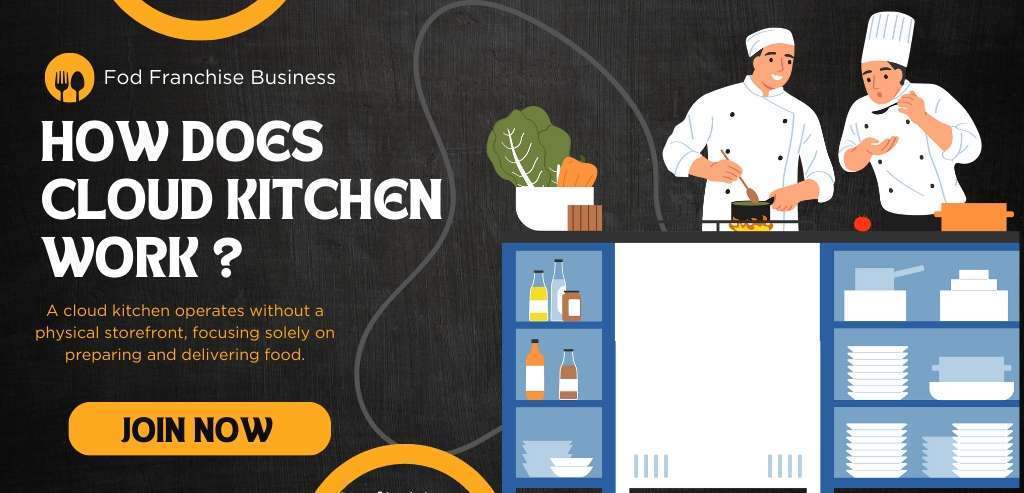Successful Business
Run A Cloud Kitchen Successful Business
In today’s digital age, the food industry is constantly evolving to meet the demands of busy consumers. One such innovation that has gained significant traction is the concept of Successful Business cloud kitchens, also known as ghost kitchens. These kitchens operate without a traditional dine-in space and focus solely on delivery and takeout orders.
If you’re considering venturing into the food business and want to explore new opportunities, running a successful cloud kitchen business in 2023 could be a lucrative option. This article will guide you through the essentials of starting and managing a cloud kitchen, highlighting its benefits along the way.
What is a Successful Cloud kitchen business ?
A cloud kitchen, also known as a ghost kitchen or virtual kitchen, is a food establishment that operates solely for delivery and takeout orders. Unlike traditional restaurants, cloud kitchens do not have a dine-in space for customers.
They focus on preparing and delivering high-quality food to consumers’ doorsteps through various online food delivery platforms. Cloud kitchens leverage technology to streamline operations, optimize efficiency, and cater to the growing demand for food delivery services.
What are some benefits of running a Cloud Kitchen?
Successful Business with the advancement of technology and changing consumer preferences, running a cloud kitchen in 2023 has become a lucrative option for aspiring restaurateurs.
Here’re some benefits of running a cloud kitchen business:
Extra Income Opportunity:
Cloud kitchens provide an excellent opportunity to generate additional income. With the growing demand for food delivery services, you can tap into a large customer base and cater to their culinary preferences without the need for a dine-in space. By focusing solely on delivery and takeout, you can optimize your operations and increase revenue potential.
Flexibility and Adaptability:
Cloud kitchens offer flexibility and adaptability compared to traditional restaurants. As a Successful Business cloud kitchen operator, you have the freedom to experiment with different cuisines, menu items, and concepts without the constraints of physical dining space. It allows you to cater to changing customer preferences and adapt quickly to market trends.
Lower Operational Costs:
Operating a cloud kitchen typically incurs lower overhead costs compared to traditional restaurants. With no need for a dining area, cloud kitchen operators can save significantly on rent, furnishings, and maintenance expenses. Additionally, efficient inventory management and optimized staffing levels contribute to cost savings, making cloud kitchens an economically viable business model.
Increased Reach and Market Penetration:
One of the key benefits of running a Successful Business cloud kitchen in 2023 is the ability to reach a larger audience and penetrate new markets. By leveraging online platforms and delivery apps, you can target customers beyond the confines of a specific location. With the growing trend of ordering food online, cloud kitchens have the advantage of catering to a broader customer base, thereby increasing revenue potential.
Efficient Order Management:
Successful Business Cloud kitchens enable efficient order management through the use of advanced technology. With the help of integrated order management systems, you can streamline the entire process, from order placement to delivery. It ensures smooth operations and minimizes errors. By optimizing order management, you can enhance customer satisfaction and build a reputation for reliability and timely service.
Enhanced Customer Experience:
In the era of convenience, customers value a seamless and personalized experience. Successful Business Cloud kitchens provide an opportunity to focus on delivering exceptional customer service. By leveraging customer data and feedback, you can tailor your offerings to meet specific preferences and requirements. Its personalized approach enhances customer satisfaction and fosters long-term loyalty.
Lower Staffing Requirements:
Compared to traditional restaurants, cloud kitchens require fewer staff members to operate efficiently. With a centralized kitchen setup, you can optimize staffing and reduce labor costs. This advantage becomes particularly significant in times of labor shortages or during unexpected situations such as pandemics or emergencies.
Adaptability to Changing Trends:
The food industry is constantly evolving, with new trends and preferences emerging. Cloud kitchens offer the flexibility to adapt quickly to these changes. Whether it’s introducing a new menu item or catering to dietary restrictions, you can easily modify your offerings based on market demand. Its adaptability ensures that your cloud kitchen remains relevant and appealing to customers in 2023 and beyond.
Quick Launch and Expansion:
Compared to traditional restaurants, cloud kitchens have a faster launch and expansion timeline. With the elimination of time-consuming processes such as interior design, construction, and acquiring permits, you can expedite the setup of your cloud kitchen. This agility allows you to capitalize on emerging opportunities and enter new markets swiftly.
Seamless Integration with Delivery Apps:
Cloud kitchens thrive on their ability to seamlessly integrate with popular food delivery apps like Swiggy and Zomato. By partnering with these platforms, you can tap into a vast customer base and benefit from their marketing reach. This integration simplifies the ordering process for customers, making it convenient and hassle-free.
Best Successful Business Opportunity in 2023:

start a cloud kitchen business. The industry is experiencing rapid growth, and the demand for food delivery services continues to rise. By capitalizing on this trend and offering unique culinary experiences to customers, you can position yourself for success and achieve significant growth in the coming years.
Franchise opportunities in the cloud kitchen sector are emerging as an exciting new franchise business idea in 2023. Established cloud kitchen brands are looking to expand their operations and offer franchise options to entrepreneurs. By partnering with a reputable cloud kitchen franchise, you can leverage their expertise, established brand reputation, and operational support to kickstart your venture.
Difference between a Restaurant and Cloud Kitchen in india.
When it comes to food businesses, different models cater to various customer needs and preferences. Two popular models are traditional restaurants and cloud kitchens. While they both involve preparing and serving food, there are significant differences between the two.
Let’s explore the distinctions between a restaurant and a cloud kitchen:
Physical Space and Ambience:One of the primary differences between a restaurant and a cloud kitchen is the physical space and ambiance they offer.
Restaurant: A restaurant typically has a physical location where customers can dine in. It often features a welcoming atmosphere with seating arrangements, decor, and a designated dining area. Restaurants are designed to provide a complete dining experience, including attentive service, ambiance, and a social setting.
Cloud Kitchen: On the other hand, a cloud kitchen, also known as a ghost kitchen or virtual kitchen, operates without a traditional dine-in space. It focuses primarily on the preparation and delivery of food. Cloud kitchens may be housed in a commercial facility with multiple kitchen spaces, each dedicated to different food businesses. These kitchens are optimized for efficiency and productivity rather than creating a dining experience for customers on-site.
Cloud Kitchen Business Model and Operations: The business model and operations of a restaurant and a cloud kitchen also differ in several aspects.
Restaurant: Restaurants generally have a broader scope of operations. They may offer an extensive menu with a variety of dishes, ranging from appetizers to desserts. Restaurants often employ a larger staff, including front-of-house and back-of-house employees, such as servers, hosts, chefs, and kitchen staff. Their operations encompass not only food preparation but also customer service, inventory management, table turnover, and maintenance of the dining area.
Cloud Kitchen: In contrast, a cloud kitchen operates with a more streamlined and focused approach. It often specializes in a specific cuisine or food concept. Cloud kitchens tend to have a limited menu, focusing on popular or niche items that can be prepared efficiently and delivered quickly. The operational emphasis is on optimizing the cooking process, packaging meals for delivery, and coordinating with delivery partners. As a result, cloud kitchens may require a smaller staff compared to restaurants.
Delivery and Takeout Focus: Another key distinction between a restaurant and a cloud kitchen is the focus on delivery and takeout services.
Restaurant: While restaurants may offer delivery and takeout options, their primary focus is often on in-person dining. They allocate resources to create a pleasant dining experience within the establishment. Takeout and delivery services may be supplementary to their core operations.
Cloud Kitchen: In contrast, cloud kitchens are specifically designed to cater to the delivery and takeout market. They prioritize the efficient preparation and packaging of meals for delivery. The physical layout of a cloud kitchen is optimized for streamlining the cooking and packaging processes, ensuring that meals reach customers promptly and in optimal condition.
Cost and Overhead Expenses: Successful Business Costs and overhead expenses also vary between a restaurant and a cloud kitchen.
Restaurant: Restaurants generally have higher upfront costs and ongoing expenses. They require a physical space, which entails rent or mortgage payments, utilities, and maintenance costs. Restaurants may also invest in interior design, furniture, and fixtures to create an inviting ambiance for guests. The larger staff and broader range of services contribute to higher labor costs.
Cloud Kitchen: Cloud kitchens, on the other hand, can be more cost-effective in terms of overhead expenses. Since they operate without a dine-in space, the costs associated with maintaining a restaurant setting are eliminated. The focus is primarily on kitchen operations, food preparation, and delivery logistics. This streamlined approach allows cloud kitchens to allocate resources more efficiently and potentially reduce costs compared to traditional restaurants.
How to start a cloud kitchen business ?
This innovative cloud kitchen business model has gained significant popularity in recent years, offering aspiring restaurateurs a cost-effective and efficient way to enter the food industry.
Research and Planning: Before diving into the world of cloud kitchens, it’s crucial to conduct thorough research and develop a comprehensive business plan. Understand the market trends, target audience, and competition in your desired location. Identify the gaps and opportunities that your cloud kitchen can capitalize on.
Define Your Concept and Target Market: Define your cloud kitchen’s concept and target market. Are you focusing on a specific cuisine, dietary niche, or customer segment? Understanding your unique selling proposition and target audience will help you tailor your offerings and stand out in the market.
Location and Infrastructure: Selecting the right location is essential for the Successful Business of your cloud kitchen. Look for a centralized area that allows for efficient food delivery and accessibility. Consider the availability of commercial kitchens or shared spaces that can accommodate your operations. Ensure that the infrastructure meets your specific requirements for food preparation, storage, and workflow.
Menu Development: Craft a well-curated menu that aligns with your concept and target market. Balance popular dishes with unique offerings to cater to a wide range of preferences. Keep in mind the practicality of preparing and delivering the items to ensure efficiency and quality.
Equipment and Technology: Successful Business Invest in high-quality kitchen equipment that suits your menu requirements. From cooking appliances and refrigeration units to food storage containers and packaging materials, ensure that you have the necessary tools to operate smoothly. Embrace technology solutions such as integrated order management systems and POS systems to streamline operations.
Staffing and Training: Build a competent and dedicated team to support your cloud kitchen operations. Hire skilled chefs, kitchen staff, and delivery personnel who understand the nuances of working in a cloud kitchen setup. Provide thorough training on food handling, hygiene practices, customer service, and technology tools to ensure a seamless experience for customers.
Online Presence and Delivery Partnerships: Establish a strong online presence to reach your target audience effectively. Create a user-friendly website or mobile app that showcases your menu, allows easy ordering, and provides essential information about your Successful Business cloud kitchen. Partner with popular food delivery platforms to expand your reach and tap into your customer base.
Marketing and Promotion: Implement a comprehensive Successful Business marketing strategy to generate awareness and attract customers to your Successful Business cloud kitchen. Leverage social media platforms, email marketing, influencer collaborations, and local advertising to spread the word about your unique offerings. Offer promotional discounts and loyalty programs to incentivize repeat orders and customer retention.
The Rolling Plate: The Best Cloud Kitchen Brand
1.What is The Rolling Plate?
Successful Business

